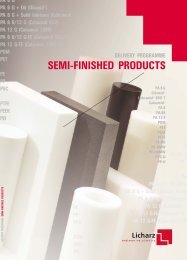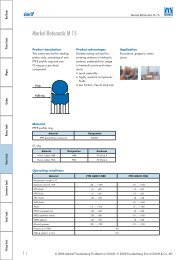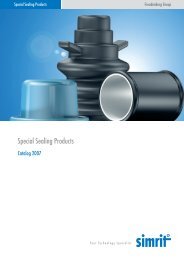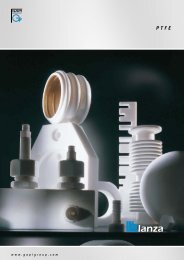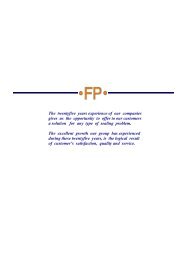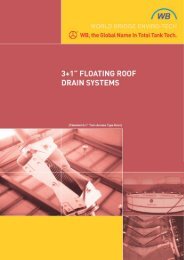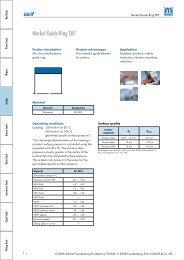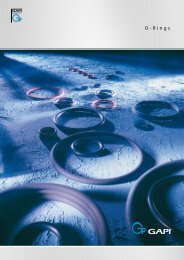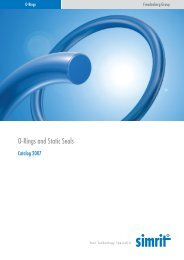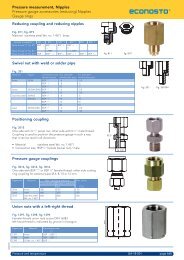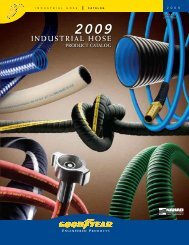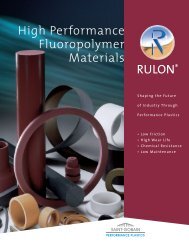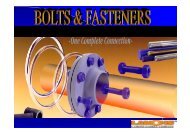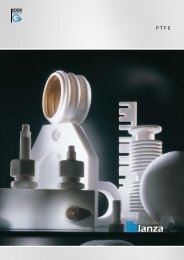Oleodinamica/Pneumatica Hydraulic/ Pneumatic
Oleodinamica/Pneumatica Hydraulic/ Pneumatic
Oleodinamica/Pneumatica Hydraulic/ Pneumatic
You also want an ePaper? Increase the reach of your titles
YUMPU automatically turns print PDFs into web optimized ePapers that Google loves.
KDSA+KDSB<br />
TEnuTA PISTOnE COMPATTA TIPO KDSA + KDSB<br />
Descrizione<br />
Per la guarnizione compatta esistono due profili:<br />
KDSA e KDSB (vedi tabella dimensionale qui di<br />
seguito).<br />
KDSA e KDSB sono costituite da un elemento centrale<br />
in gomma nitrilica che esercita la funzione di tenuta,<br />
da due supporti laterali all’elemento in gomma che<br />
agiscono da anelli antiestrusione e da due guide<br />
esterne che mantengono in guida il pistone nel<br />
cilindro.<br />
Dati tecnici<br />
Pressione: da 0 a 300 bar con punte fino a 400<br />
bar a 60° C<br />
Velocità: < 0.5 m/s<br />
Temperatura: da - 30° C a +100° C<br />
Fluidi: Oli a base minerale<br />
(vedi TABELLA I, pagg. 10-11)<br />
Materiale<br />
I materiali utilizzati per la costruzione di questo tipo<br />
di tenuta sono i seguenti:<br />
- l’elemento centrale è in NBR con durezza 70 Sh A ±<br />
3<br />
- i supporti laterali sono in elastomero termoplastico<br />
(TPE)<br />
- le guide esterne sono in resina poliacetalica (POM)<br />
Codice materiale: CX<br />
Montaggio<br />
Il montaggio di questa tenuta può essere eseguito<br />
sia in cava chiusa su pistone monoblocco, sia in cava<br />
aperta su pistone in due pezzi.<br />
L’ordine di montaggio deve essere il seguente:<br />
1 - elemento in gomma;<br />
2 - supporti;<br />
3 - guide.<br />
E’ necessario che il pistone non presenti bave<br />
di lavorazione meccanica che danneggerebbero<br />
l’elemento in gomma durante il montaggio.<br />
<strong>Oleodinamica</strong> & <strong><strong>Pneumatic</strong>a</strong><br />
COMPACT PISTOn SEAL TyPE KDSA + KDSB<br />
Description<br />
In the compact seals two profiles are available: KDSA<br />
and KDSB (see the dimensions table).<br />
KDSA and KDSB are composed of a central unit<br />
made of nitrilic rubber working as a seal, two side<br />
supports, working as anti-extrusion rings, and two<br />
external guide rings, keeping the piston position in<br />
the cylinder aligned.<br />
Technical data<br />
Pressure: from 0 to 300 bar with peaks till 400<br />
bar at 60° C<br />
Speed: < 0.5 m/s<br />
Temperature: from - 30° C to +100° C<br />
Fluids: Mineral oils<br />
(see TABLE I, pages 10-11)<br />
Material<br />
The compounds used to manufacture this seal type<br />
are the following:<br />
- the central unit is made of NBR, the hardness is 70<br />
Sh A ± 3<br />
- the side supports are made of thermoplastic<br />
elastomer (TPE)<br />
- the external wear rings are made of polyacetalic<br />
resin (POM)<br />
Compound reference: CX<br />
Assembly<br />
The assembly of this seal can be ca ried out in either<br />
closed groove, on a monobloc piston, or in open<br />
groove, on a two-part piston.<br />
The assembly order is as follows:<br />
1 - rubber element;<br />
2 - supports;<br />
3 - wear rings.<br />
The piston must not have machining scores which<br />
might damage the rubber unit during the installation.



